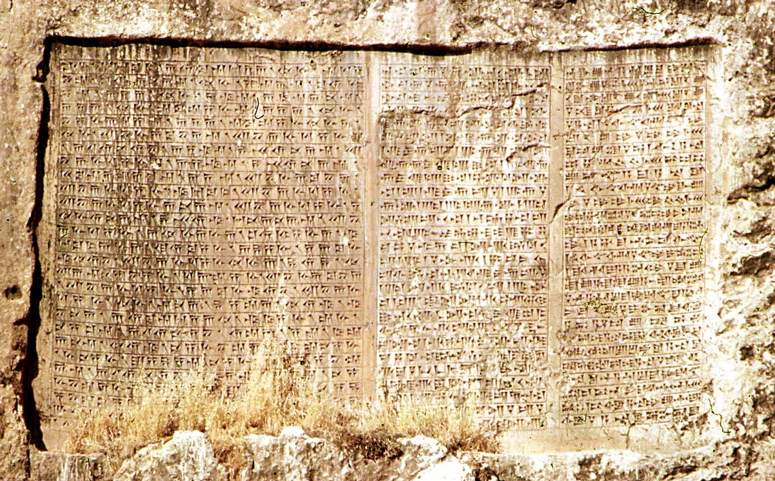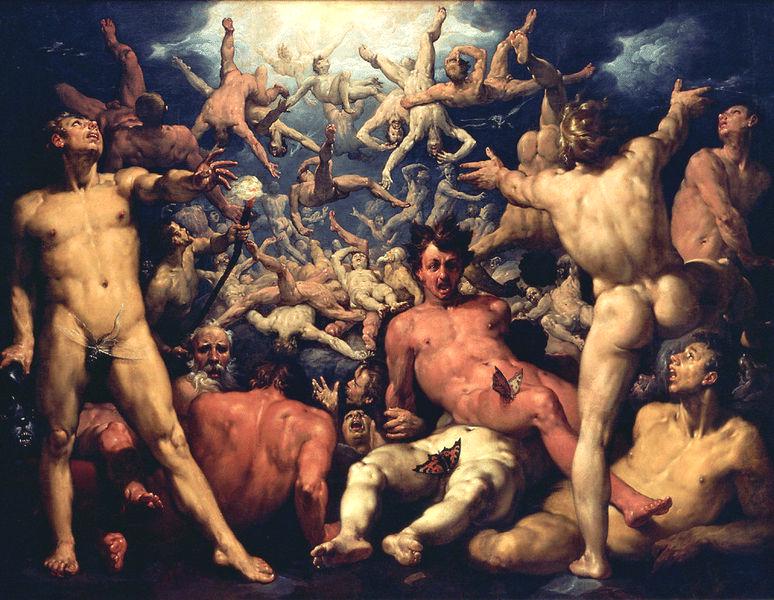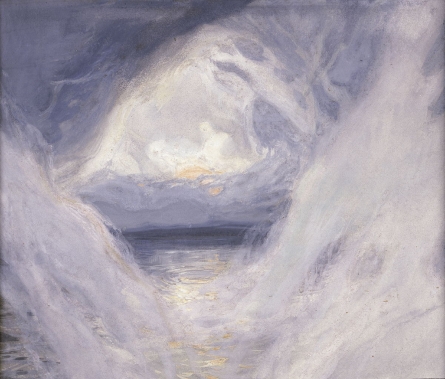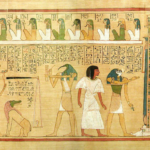The Enûma Eliš: Sumer- Babylonian Creation Mythos
Like all ancient mythological traditions, in order to have a contextual understanding of ancient myth and the culture within which it evolved, one must look at the historical and archeological record, along with the extant textual and writing material, most of which comes down to us in fragmentary form. Understanding the context within which a text or its fragments is found, from an archeological perspective, gives us a better understanding as to the role of the text, its purpose, and what type of variants or textual/manuscript tradition which the writing can be comprehended and best understood. This is really the only method that can be used to attain a proper understanding of ancient “literature”, especially when analyzing it in a translated/transliterated form. This allows us to, at least as much as possible, to get a sense as to the cultural and sociological milieu surrounding the text and grasp as much as possible the history and the belief systems of the author.
Archeologists have found cuneiform tablets from as early back as 3400 BC, roughly corresponding to the advent of civilization in Ancient Egypt, and the last known cuneiform tablet is from the latter part of the first century CE. So this dead language, or script, was actually in use for around 4000 years and during that time was adapted to support the inscription of a variety of spoken languages, ranging from Akkadian[1] and Hittite tongues, to of course the better known Sumerian. It is also a commonly held belief that cuneiform inspired several other alphabet systems that followed it, the Ugaritic and Old Persian alphabets for example. Cuneiform writing was gradually replaced by the Phoenician alphabet however, a precursor to the Greek alphabet system[2], and by the 2nd century CE, the script had become all but extinct.
Cuneiform was represented by wedge shaped markings, referring to the method and look of the markings as they were born out on the clay tablets that they were carved on, by stylus or pens of sorts which facilitated the script on the clay. One of the reasons why so much of this writing has survived is the instrument that it was written on, i.e. the clay tablets. A much more lasting and persistent archeological artifact than say papyrus, which was used by the Egyptians, or certainly silk which was commonly thought to have been used by the ancient Chinese. The pen that was used to craft the characters, looked something like a chopstick with a sharp edge at the end to carve the characters and symbols onto the clay. The wedge-shaped characters are where the name of the ancient script got its name in fact, wedge in Latin was cuneus.

Figure 6: Example of cuneiform script writing from the Achaemenid Empire (c 5th century BCE)[3]
The Enûma Eliš is the best known and most commonly referred to text that represents this creation mythological narrative from the ancient Sumer-Babylonian people, a myth that gets its name after the first two words of the first clay tablet. The text exists in various copies from ancient Babylon and Assyria and is believed to have been composed in the Bronze Age, roughly 18th to 16th centuries BCE, roughly corresponding to the early Assyrian Empire which is believed to have existed as an independent kingdom in the Mesopotamian region starting from roughly the middle of the third millennium BCE until it collapsed in the middle of the first millennium BCE. It is during this time period that the myth and tablets are believed to have been created and transcribed. Unlike the Egyptian cultural remnants which primarily come from burial formations – Coffins and Pyramids (hence the name of the primary textual sources of ancient Old Kingdom Egypt, i.e. the Pyramid Texts and Coffin Texts), from ancient Sumerian-Babylonian civilization, a culture and people that evolved around the Tigris-Euphrates Valley, there exist several versions of almost complete versions of their creation myths.
The complete story was recorded on clay tablets and is around one thousand lines. It was recorded in the Old Babylonian, or Akkadian language. The text and the verses therein were associated with the Babylonian New Year festival, so there was a ritual use for the material as well as socio-political (Marduk being a Babylonian deity in origin), hence the various tablet findings that survive that give us a full textual tradition, at least as full as can be expected from that time period in antiquity. From this perspective, we clearly see strong parallels to the Egyptian cosmological narratives which were drawn up and affiliated with the reigns of various Egyptian kings throughout its long history, associated with various political capitals and temples of worship which existed therein as well as parallels with Old Testament stories, in particular the stories of creation and the Great Flood which are narrated in the first five books of the Old Testament, i.e. the Five Books of Moses.
The Enûma Eliš myth is the primary source of creation mythology of the ancient Sumer-Babylonians and represents a fairly mature rendering of creation mythology as well as reflecting a fairly consolidated socio-political structure within which the myth, and its associated rituals and rites within which it was recited, are believed to have been performed. Although a work of mythology and theological significant no doubt, the text and the context within which it was preserved shows a strong political influence as well, as it was clearly written (and copied) for the purpose of justifying the supremacy of the Babylonian God Marduk above all other Mesopotamian gods, no doubt to consolidate and affiliate the ruler/king of the Assyrian Empire to this ancient deity.[4]
The Enûma Eliš, or Enuma Elish, loosely translated into English as something like “when on high”, a title given to it from the first few words of the text as was a common tradition in antiquity, begins with the following passage which describes the creation of the universe and the establishment of the structural elements and deities that they represented therein:
When in the height heaven was not named,
And the earth beneath did not yet bear a name,
And the primeval Apsû, who begat them,
And chaos, Tiamat, the mother of them both
Their waters were mingled together,
And no field was formed, no marsh was to be seen;
When of the gods none had been called into being,
And none bore a name, and no destinies were ordained;
Then were created the gods in the midst of heaven,
Lahmu and Lahamu were called into being…
Ages increased,…
Then Ansar and Kisar were created, and over them….
Long were the days, then there came forth…..
Anu, their son,…
Ansar and Anu…
And the god Anu…
Nudimmud, whom his fathers, his begetters…..
Abounding in all wisdom,…’
He was exceeding strong…
He had no rival –
Thus were established and were… the great gods.[5]
In the beginning, we have the existence of a primordial watery abyss, of which two basic male and female correspondent and coexistent deified principals are called out – Apsû and Tiamat respectively. The first representing the ordered or structured aspect, the seed, and the latter representing the more chaotic and destructive (female) aspect. These two primary entities or forces become the source from which all the other major gods and goddesses emanate, and from which the earth, sky, sun, moon and stars are created, again similar to the narrative from the other contemporary mythologies we find in the Mediterranean.
This initial primordial substance, described as a “watery abyss” and “chaotic” in the Sumer-Babylonian mythos, or that which lacks order and justice in the various creation mythologies in the Mediterranean region in antiquity, starts as initially “disordered” and ungerminated. Then via the act, or in some traditions via the spoken word or thought, of the first principal or being/deity the ordered cosmos starts to unfold and the first generation of gods representing the basic forces of nature is born. At the very beginning of the story of creation then, we see the existence of two primordial forces – one male and one female – from which the universe and the deities are begotten. You have this unformulated ocean like substance deity who bears all pantheon of gods and goddesses, Tiamat, a female goddess associated with the ocean or salt water, and then the progenitor male deity, Apsû[6], Akkadian the god who presides over fresh water, which was believed by the ancient Sumer-Babylonians, not surprisingly, to represent the spring and source of life.
These respective primordial male and female gods or entities then exist prior to, and must in fact come together, before the sky and earth, the material and heavenly realms, can come into existence. Then Lahmu and Lahamu are created (“slime” or “mud” and “silt” or “salt”, male and female respectively), alluding to the establishment of the primary elements of creation upon which the universe and the later deities in the Sumer-Babylonian pantheon can come forth. Ansar and Kisar are then created, “heaven” (male) and the “whole earth” (male) or perhaps better understood as “material universe”. Then comes Anu, a male deity representing the sky (as distinct from ‘heaven’, represented by his father Ansar) and then Nudimmud, or the “image fashioner” come into being. Thus is established the Sumer-Babylonian pantheon of gods who preside over creation before the lesser gods are born, of which of course Marduk plays a central role.[7]
The Enûma Eliš then relays in graphic detail the story of the struggle between the begetter gods of Apsû and Tiamat and their offspring, a struggle which culminates in the destruction of the powers and followers of Tiamat – led by her offspring Kingu – which are ultimately defeated by Marduk, the son of Ea (Enki) and Damkina, the great Mother goddess of Sumer-Babylonian mythos.
Then advanced Tiamat and Marduk, the counselor of the gods;
To the fight they came on, to the battle they drew nigh.
The lord spread out his net and caught her,
And the evil wind that was behind him he let loose in her face.
As Tiamat opened her mouth to its full extent,
He drove in the evil wind, while as yet she had not shut her lips.
The terrible winds filled her belly,
And her courage was taken from her, and her mouth she opened wide.
He seized the spear and burst her belly,
He severed her inward parts, he pierced her heart.
He overcame her and cut off her life;
He cast down her body and stood upon it.
When he had slain Tiamat, the leader,
Her might was broken, her host was scattered.
And the gods her helpers, who marched by her side,
Trembled, and were afraid, and turned back.
They took to flight to save their lives;
But they were surrounded, so that they could not escape.
He took them captive, he broke their weapons;
In the net they were caught and in the snare they sat down.
The … of the world they filled with cries of grief.
They received punishment from him, they were held in bondage.
And on the eleven creatures which she had filled with the power of striking terror,
Upon the troop of devils, who marched at her…,
He brought affliction, their strength he…;
Them and their opposition he trampled under his feet.
Moreover, Kingu, who had been exalted over them,
He conquered, and with the god Dug-ga he counted him.
He took from him the Tablets of Destiny that were not rightly his,
He sealed them with a seal and in his own breast he laid them.[8]
After a rebellion and betrayal in the midst of the primordial gods, the first generation of gods and goddesses and their offspring, led by Tiamat and her son Kingu, Marduk assumes dominion over the world of immortal gods. The story is not only reminiscent of the battle between Zeus and the Titans, also the progeny of the first generation of gods which plays such a prominent role in the Theogony of Hesiod, but also the battle fought between Osiris and Set from which Horus – the Egyptian counterpart to the Sumer-Babylonian Marduk and the Greek Zeus – establishes himself as the ruler of the pantheon from ancient Egypt.
Much like Ma’at of the Egyptians, and the Greek Hermes, Marduk is accredited not only with the establishment of order and justice in the realm of the divine, but also with the establishment of the final order of the material universe and the world of man – creating the stars in the heavens, the zodiac and the precessions of the seasons, as well as the calendar to measure time which included in the Sumer-Babylonian tradition the 12 months of the year, and the Sun and Moon to govern time.
He (Marduk) made the stations for the great gods;
The stars, their images, as the stars of the Zodiac, he fixed.
He ordained the year and into sections he divided it;
For the twelve months he fixed three stars.
After he had … the days of the year … images,
He founded the station of Nibir [the planet Jupiter] to determine their bounds;
That none might err or go astray,
He set the station of Bel and Ea along with him.
He opened great gates on both sides,
He made strong the bolt on the left and on the right.
In the midst thereof he fixed the zenith;
The Moon-god he caused to shine forth, the night he entrusted to him.
He appointed him, a being of the night, to determine the days;
Every month without ceasing with the crown he covered him, saying:
“At the beginning of the month, when thou shinest upon the land,
Thou commandest the horns to determine six days,
And on the seventh day to divide the crown..[9].
So while the theogony related in the Enûma Eliš represents a distinctive tale and has very specific Sumer-Babylonian characteristics, we nonetheless find very common motifs therein which align Sumer-Babylonian mythos, as we see it in the Enûma Eliš, with other creation mythos in antiquity, especially from in and around the Mediterranean – most notably the Hebrew narrative we find in Genesis, Hellenic theogony in Hesiod’s rendition of world creation, as well as the creation mythos we find in ancient Egypt as well.
This universal order as the ancients understood it was reflected, and anthropomorphized, in this initial pantheon of gods that were created as part of the establishment of the cosmos at the beginning of Time, with the most primordial of beings coming forth first and then the lesser, or more shaped or well-formed aspects of creation coming afterwards, with ultimately all of the different aspects of nature – Earth, Air, Water, Sky, Sun, Moon, etc. – being brought forth as it were and then ultimately a king or ruler of the gods being crowned at the end Mankind, the “prototypical man” as it were, is typically shaped or crafted through clay or by some other means at the end of these theogonies, such as we see in Genesis for example with Adam. These theogonies – or cosmogonies as we refer to them sometimes which carries with it more philosophical, or metaphysical connotations – establish not only the socio and cultural specific narrative (what we have come to understand and refer to as “myth”) as to how the world came into being, but also the basic, and fundamentally divine, structure of their world through which not only the cycle of Time is established as it is measured by Day, Night, the Moon and Stars, but also the basic theological framework and deities who could, and most certainly should, be worshipped in their various forms and specific attributes via various rites and rituals so that their world could be preserved and maintained.
These creation tales, i.e. our mythos – and again this is common throughout antiquity in the cultures and civilizations through Eurasia, Sumer-Babylon being no exception – typically end in the overthrow of some vicious tyrant god by a benevolent child of the second or third generation deities who establishes order and justice throughout the world of immortals, the beings who are co-emergent with creation itself and who dwell in the Heavens amidst the Stars and in the Sky. This leader of the gods then, the Sumer-Babylonian Marduk or the Hellenic Zeus serve as prime examples, not only establishes and keeps order in the Heavens, but also is the divine being who is responsible for, and whose worship and fealty in turn provides the basis for harmony and balance, and preservation really, in the world of man as well – to keep the society safe and flourishing and to protect it from the onslaught of neighbors or attack which was invariably a concern for almost all ancient peoples in one form or another. The king or ruler of each of these ancient societies usually claimed his power and legitimacy through this leader of the divine immortal pantheon of gods, either through direct descent or through some other means of divine heritage, aligning and legitimizing their rule with the universal cosmic order as it were, providing the basis for the divinity of these rulers and kings as well, who in many cases were also worshipped as gods, the Egyptian pharaohs perhaps being the best example.
The mythos of the Sumer-Babylonian civilization that centered around the Tigris-Euphrates Valley was no different, with primordial the Apsû and Tiamat providing the basis from which the universe comes into being, corresponding more or less with the Nu and Naunet of the Egyptians and from which Marduk comes forth as the ultimate leader of the gods who through various acts of miraculous heroism comes to be king of the gods and as such ultimately responsible for the well-being of the Sumer-Babylonian people who were in his charge so to speak. This creation narrative that we find in the Enûma Eliš, is essentially the same in structure and form that we find in the Hellenic rendition as told by Hesiod, as well as the Indian/Hindu rendition as well as we find in the Vedas and the Purāṇas, with a few local variations of course.
We also find in the Sumer-Babylonian tradition the creation of anthropomorphic deities, the second generation of gods, which establish and keep order and justice in the universe, a concept that we see in virtually all of the mythos from antiquity throughout Eurasia in fact. Furthermore, in each of these ancient creation narratives with again the Sumer-Babylonia tradition being no exception, these anthropomorphic deities emerge out of a watery and abysmal chaotic void or abyss, through which ultimately the universe is shaped and ordered, with these deities being co-emergent with it and at the same time responsible for its preservation as well. One can also clearly see a consistent socio-political purpose behind the creation myths of the Egyptians and Sumerians, the need to establish the preeminence of the one ruler of society as manifest in one chieftain or ruler whose authority is established via the primary deity of the people. Ancient cultures were certainly marked by a priesthood class that was legitimized by the ruler of the people which in turn rested upon the common mythology from which authority was established and divined – hence the worship of these ancient kings and pharaohs as divine.
It’s fair to say that both the ancient Egyptian and Sumer-Babylonian mythological traditions – and to a lesser extent the mythology of the Hebrews – speak of and hold great reverence for the deity or principal who establishes and maintains order in the world, for which the king or leader of the respective peoples is held ultimately responsible and from which their authority is established. The Greco-Roman and Hebrew mythological traditions as reflected in the works of Hesiod, Ovid and Moses, all which evolved in the roughly the same geographic region, were clearly influenced by their Sumer-Babylonian and Egyptian predecessors and carried very similar narratives and motifs albeit in different terms with different deities and in different languages (both spoken and written).
One of the most prominent features of ancient society is the connection between the ruling class (kings and priests) and the respective mythos of said society – what scholars refer to as “civilization”. In these ancient socio-political structures, again these civilizations, socio-political structures that were defined more or less by their language and their “culture”, there exists a very strong correlation, a dependence really, between the authority of the ruling class – kings, aristocrats and priests – and their respective mythos. For it is through the myths themselves, and their associative rituals, rites and festivals which were intimately and intrinsically tied to said myths, that not only bound the people together – provided the cultural foundations as it were – but also provided the legitimacy of the ruling class.
For the ruling class, the pharaohs and emperors were considered to be of divine heritage, tracing their lineage back through the mythos to the presider over the universe himself, i.e. God, or Marduk in the case of the Sumer-Babylonians. In the cosmic, universal sphere, it was God who held dominion, who through his power provided order and support, and balance and harmony (as juxtaposed from the primordial chaos from which the ordered universe emerged), to the previously disordered and chaotic universe. In the human sphere, reflected in the socio-political structures of these ancient societies, it was the king or emperor that provided order, balance and harmony for their respective people, using the powers that had been granted to him from his (or her) lineage, from the gods themselves, through the rites and rituals presided over by the priests, the messengers of the divine.
It is this picture that essentially describes the relationship between the ruling class and the divine for almost all of the ancient civilizations that we see emerge in and around the Mediterranean, and to the East in Asia Minor and Persia, in antiquity from the 4th to the 1st millennia BCE, up until the Christian Era really – where power and political authority in particular was understood, legitimized and justified through the lens of the respective cultural mythos of said civilization, an intellectual framework which, in today’s terminology, provided the underlying theological framework of said (ancient) culture. And certainly the Sumer-Babylonians, whose mythos, and cosmogony, is captured so eloquently in the epic tale we know as the Enûma Eliš, we can see a very good example of this, where the cosmogony dovetails into the foundation of society quite clearly, providing the shared mythos to support the Sumer-Babylonian civilization itself.
[1] Akkadian (aka Assyro-Babylonian) is an extinct Semitic language that was spoken in ancient Mesopotamia. The earliest attested Semitic language, it was captured and inscribed using the cuneiform writing system and is believed to have derived from an ancient, now lost, Sumerian language. The name of the language is derived from the city of Akkad, a major center of Mesopotamian civilization.
[2] See Wikipedia contributors, ‘History of the Greek alphabet’, Wikipedia, The Free Encyclopedia, 17 July 2016, 09:00 UTC, <https://en.wikipedia.org/w/index.php?title=History_of_the_Greek_alphabet&oldid=730184436> [accessed 22 August 2016]
[3] Inscription of Xerxes, Van, Turkey It is a trilingual inscription, written in Old Persian, Babylonian and Elamite (from left to right). From Wikipedia contributors, ‘History of the Greek alphabet’, Wikipedia, The Free Encyclopedia, 17 July 2016, 09:00 UTC, <https://en.wikipedia.org/w/index.php?title=History_of_the_Greek_alphabet&oldid=730184436> [accessed 22 August 2016].
[4] All of the myth has survived except for the majority of the last chapter, Tablet V, which has yet to be discovered. Aside from this lost portion however, the text is almost complete. For a good translation of the text with notes see http://www.sacred-texts.com/ane/blc/blc07.htm. Also see Wikipedia contributors, ‘Enûma Eliš’, Wikipedia, The Free Encyclopedia, 5 August 2016, 15:29 UTC, <https://en.wikipedia.org/w/index.php?title=En%C3%BBma_Eli%C5%A1&oldid=733127460> [accessed 22 August 2016].
[5] ENUMA ELISH, THE EPIC OF CREATION. L.W. King Translator, from The Seven Tablets of Creation, London 1902. From http://www.sacred-texts.com/ane/enuma.htm
[6] A more literal etymological translation of “Apsû” being something like “knowledge of the deep” – as/ab=’ocean’ zu=’to know’ or ‘deep’.
[7] See http://faculty.gvsu.edu/websterm/enuma_elish.html for a good overview of the deities and their representative figures or forces.
[8] ENUMA ELISH THE EPIC OF CREATION L.W. King Translator. From The Seven Tablets of Creation, London 1902. End of Fourth Tablet. From http://www.sacred-texts.com/ane/enuma.htm.
[9] ENUMA ELISH THE EPIC OF CREATION L.W. King Translator. From The Seven Tablets of Creation, London 1902. First verses of Fifth Tablet. From http://www.sacred-texts.com/ane/enuma.htm.







Leave a Reply
Want to join the discussion?Feel free to contribute!